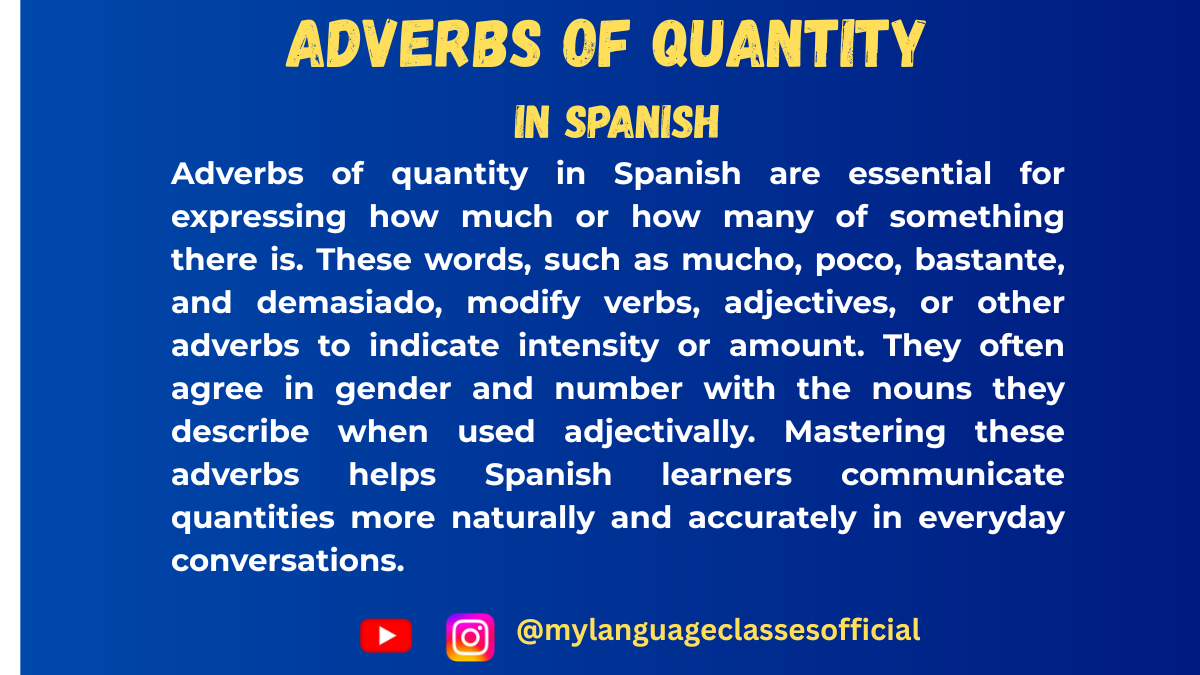Your cart is currently empty!
Tag: world of languages
-
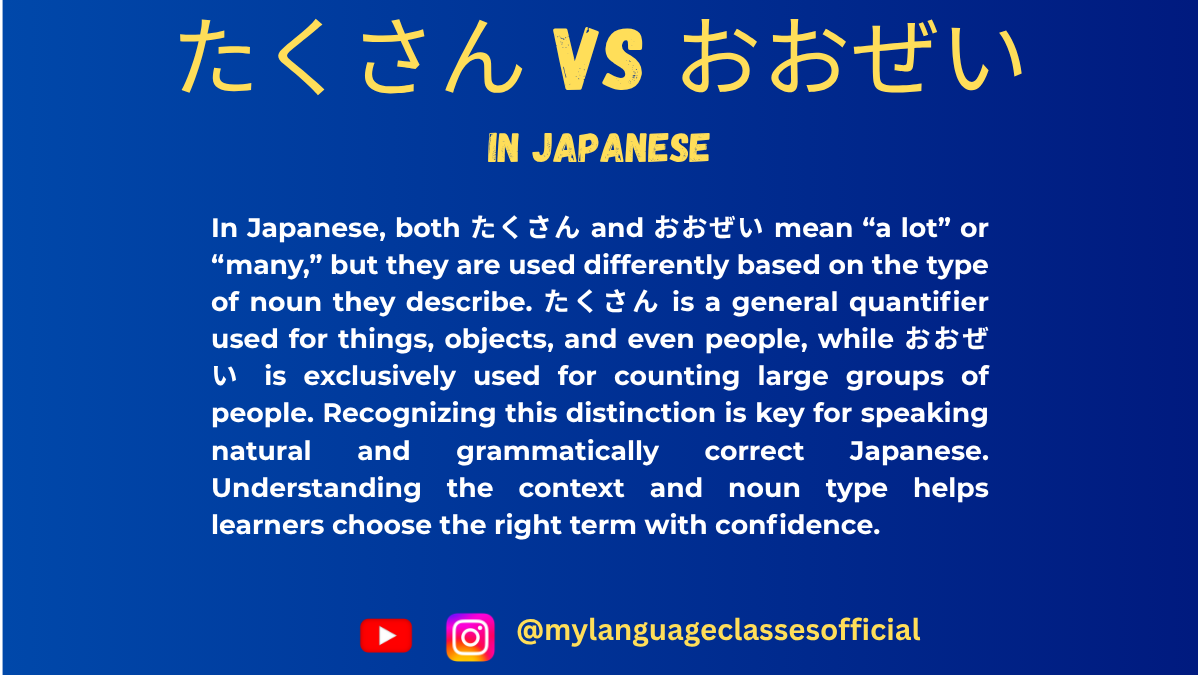
たくさん vs おおぜい: the Differences in Japanese | My Language Classes
たくさん vs おおぜい
When learning Japanese, many students come across the words たくさん (takusan) and おおぜい (oozei), both of which mean “a lot” or “many.” However, they are not interchangeable in every situation. Understanding their nuances will help you use them naturally in conversations and writing.
1. Basic Meaning and Key Difference
- たくさん (takusan): Means “a lot,” “many,” or “plenty” and can be used for both countable and uncountable nouns.
- おおぜい (oozei): Specifically refers to “a large number of people” and is used only for people.
2. Usage of たくさん (takusan)
A. With Countable and Uncountable Nouns
- たくさん can be used with both things that can be counted (books, apples, pens) and things that cannot be counted (water, happiness, love).
Examples:
- 机の上に本がたくさんあります。
Tsukue no ue ni hon ga takusan arimasu.
→ There are many books on the desk. - 今日は仕事がたくさんあります。
Kyou wa shigoto ga takusan arimasu.
→ I have a lot of work today. - 私はお金をたくさん持っています。
Watashi wa okane o takusan motteimasu.
→ I have a lot of money.
B. Placement of たくさん in a Sentence
- Before the noun (less common in daily speech):
- たくさんの友達がいます。(Takusan no tomodachi ga imasu.)
→ I have many friends.
- たくさんの友達がいます。(Takusan no tomodachi ga imasu.)
- After the noun (more natural):
- 友達がたくさんいます。(Tomodachi ga takusan imasu.)
→ I have many friends.
- 友達がたくさんいます。(Tomodachi ga takusan imasu.)
- With verbs (indicating an action done in large amounts):
- ご飯をたくさん食べました。(Gohan o takusan tabemashita.)
→ I ate a lot of food.
- ご飯をたくさん食べました。(Gohan o takusan tabemashita.)
3. Usage of おおぜい (oozei)
A. Used Only for a Large Number of People
- おおぜい is exclusively used when talking about a crowd, a large number of people, or a gathering.
Examples:
- コンサートにはおおぜいの人が来ました。
Konsaato ni wa oozei no hito ga kimashita.
→ A large number of people came to the concert. - その町には観光客がおおぜいいました。
Sono machi ni wa kankoukyaku ga oozei imashita.
→ There were many tourists in that town. - おおぜいの学生が試験を受けました。
Oozei no gakusei ga shiken o ukemashita.
→ A lot of students took the exam.
B. Placement of おおぜい in a Sentence
- Before the noun:
- おおぜいの人が集まりました。(Oozei no hito ga atsumarimashita.)
→ Many people gathered.
- おおぜいの人が集まりました。(Oozei no hito ga atsumarimashita.)
- After the noun (less common but acceptable):
- 人がおおぜい集まりました。(Hito ga oozei atsumarimashita.)
→ A lot of people gathered.
- 人がおおぜい集まりました。(Hito ga oozei atsumarimashita.)
4. Situations Where たくさん and おおぜい Are Used
Situation Use たくさん Use おおぜい Talking about a large number of objects (books, apples, cars, etc.) ✅ Yes ❌ No Talking about a large quantity of uncountable things (water, love, money, etc.) ✅ Yes ❌ No Talking about a large number of people ✅ Yes ✅ Yes Talking about a crowd or a gathering of people ❌ No ✅ Yes Used with verbs like “eat” or “buy” (大量に食べる, 大量に買う) ✅ Yes ❌ No Used before a noun as an adjective ✅ Yes (たくさんの) ✅ Yes (おおぜいの) Used after a noun naturally ✅ Yes ✅ Yes (but limited to people) 5. Summary of Key Differences
Word Meaning Used for Example Sentence たくさん (takusan) A lot, many, plenty Both people and things 友達がたくさんいます。 (I have many friends.) おおぜい (oozei) A large number of people, crowd Only people コンサートにおおぜいの人が来ました。 (A large number of people came to the concert.) 6. Common Mistakes to Avoid
- ❌ おおぜいの本があります。 (Oozei no hon ga arimasu.) → Incorrect, because おおぜい is only for people.
- ✅ たくさんの本があります。 (Takusan no hon ga arimasu.) → Correct, because たくさん can be used for books.
- ❌ たくさんの人がいた。 (Takusan no hito ga ita.) → Grammatically correct, but おおぜいの人がいた sounds more natural when referring to a crowd.
7. Conclusion
Both たくさん and おおぜい mean “many,” but their usage differs depending on what you are referring to. たくさん is more versatile as it can be used with both things and people, while おおぜい is exclusively used for a large number of people. By keeping these differences in mind, you can use these words accurately and naturally in your Japanese conversations!
By mastering these distinctions, you can enhance your fluency and express yourself more precisely in Japanese. Keep practicing, and soon using たくさん and おおぜい correctly will become second nature! Happy learning! 😊
If you enjoyed this lesson, be sure to check out more posts like this on my blog at My Language Classes. Don’t forget to subscribe my YouTube channel and follow me on Instagram for the latest language learning tips and lessons. Leave a comment below to share your thoughts, or ask any questions you have about nouns.
Happy learning! 😊
-
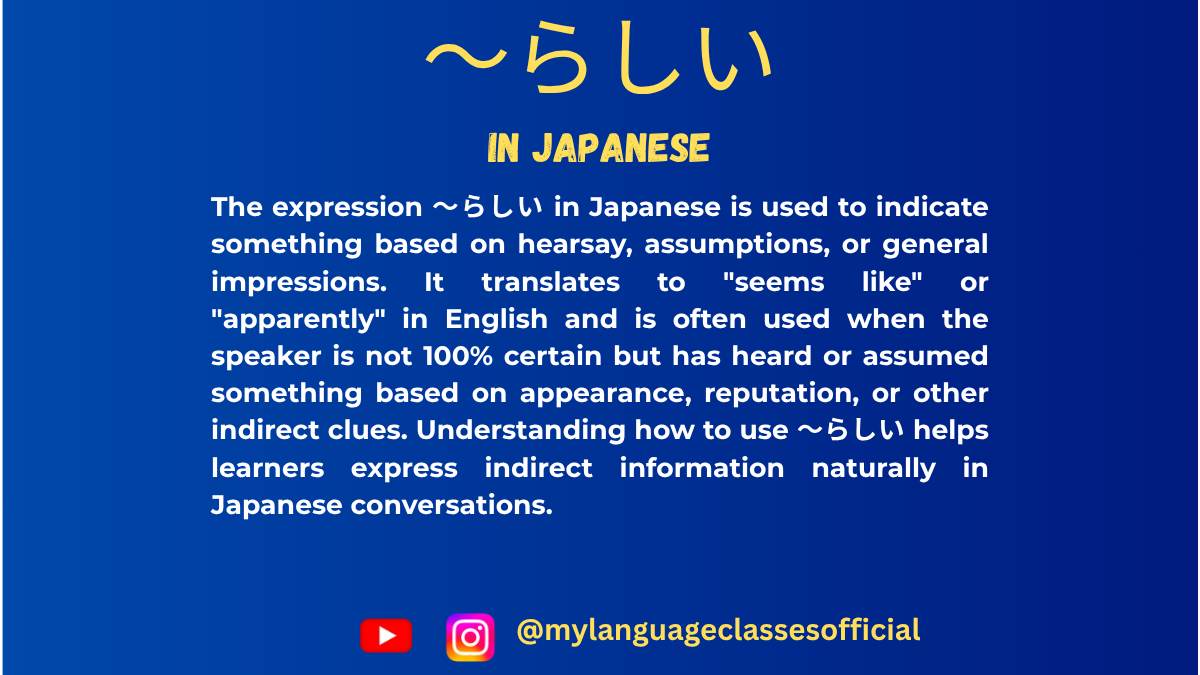
Understanding 〜らしい in Japanese | My Language Classes
Understanding 〜らしい in Japanese
When learning Japanese, one of the essential expressions to understand is 〜らしい. This suffix plays a vital role in expressing assumptions, hearsay, characteristics, and appropriateness. In this blog post, we will explore all possible usages of 〜らしい, providing clear explanations and examples.
1. Expressing Hearsay or Second-hand Information
One of the most common uses of 〜らしい is to indicate information that the speaker has heard from someone else but has not personally verified.
Structure:
Verb (Plain Form) + らしい
い-adjective (Plain Form) + らしい
な-adjective + らしい
Noun + らしいExamples:
- そのレストランは美味しいらしいよ。
(I heard that restaurant is delicious.) - たろうは今日休むらしい。
(I heard that Tarou is taking the day off today.) - この映画はめちゃくちゃ面白いらしい。
(I heard that this movie is really interesting.)
Usage Note:
Compared to そうだ, which is also used for hearsay, らしい implies that the information is based on indirect sources rather than direct observation.
2. Expressing Assumptions or Inferences
Another way to use 〜らしい is when making an assumption based on evidence.
Examples:
- たくさんの人が黒い服を着ている。 お蔵式があったらしい。
(Many people are wearing black clothes. It looks like there was a funeral.) - あの子はプロ野球選手の子どもらしい。
(That child seems to be the son of a professional baseball player.)
Usage Note:
This is different from ようだ, which is used for assumptions based on visual evidence, whereas らしい is based on reasoning or known facts.
3. Expressing Typical Characteristics
〜らしい can also be used to describe something that has the typical characteristics of a person, thing, or behavior.
Examples:
- このラーメンは日本らしい味だね。
(This ramen has a very “Japanese” flavor.) - かれは仕事に小さいことまで注意を払う。真面目らしい人だ。
(He pays attention to small details in his work. He is a serious person.) - 她はいつも元気で、すごく子どもらしい。
(She is always energetic, very much like a child.)
Usage Note:
This usage expresses the “essence” of something or someone. It is similar to みたい but is more about inherent qualities rather than just resemblance.
4. Expressing Suitability or Appropriateness
In some cases, 〜らしい can be used to indicate something that fits a certain expectation or role.
Examples:
- 日本らしいけしきゃんの誕生日プレゼントを買いたい。
(I want to buy a birthday present that is “Japanese-like”.) - 少年らしい仕事を求めている。
(Looking for work suitable for young people.)
Usage Note:
This is closely related to the “typical characteristics” meaning but emphasizes suitability rather than mere resemblance.
Situations Where 〜らしい is Used
Below is a list of common situations where 〜らしい is applicable:
- Hearsay – When conveying information heard from others.
- Inference – When making an assumption based on indirect evidence.
- Typical Characteristics – When describing something as having the essence of a person, thing, or behavior.
- Suitability – When expressing something as being appropriate for a certain role or image.
- Rumors – When talking about unverified rumors or gossip.
Final Thoughts
Mastering 〜らしい is essential for expressing assumptions, typicality, and hearsay in Japanese. While it might seem tricky at first, practicing with real-life examples and distinguishing it from similar expressions like そうだ and ようだ will help you use it naturally.
By understanding these nuances, you’ll be able to sound more fluent and natural in your Japanese conversations. Keep practicing, and don’t hesitate to use 〜らしい in different situations!
If you enjoyed this lesson, be sure to check out more posts like this on my blog at My Language Classes. Don’t forget to subscribe my YouTube channel and follow me on Instagram for the latest language learning tips and lessons. Leave a comment below to share your thoughts, or ask any questions you have about nouns.
Happy learning! 😊
- そのレストランは美味しいらしいよ。
-

Adverbs of Place in Spanish: A Complete Guide
Adverbs of place (adverbios de lugar) are essential in Spanish to indicate where an action takes place. They help provide spatial context and are frequently used in daily conversations. In this blog, we will explore the most common adverbs of place, their meanings, and how to use them correctly in sentences.
Understanding Adverbs of Place
Adverbs of place describe the location of an action or object. They answer the questions: Where? (¿Dónde?) and To where? (¿Adónde?)
These adverbs do not change in gender or number, as adjectives do, but their placement and meaning depend on the sentence context.
Common Adverbs of Place and Their Meanings
Spanish Adverb Meaning Aquí Here Allí There (not too far) Allá Over there (far away) Cerca Near Lejos Far Encima On top Debajo Below, under Enfrente In front Detrás Behind Dentro Inside Fuera Outside Al lado Next to, beside Entre Between Alrededor Around
Common Expressions with Adverbs of Place
Here are some daily expressions using adverbs of place with their meanings and example sentences:
1. Aquí (Here)
- Estoy aquí. (I am here.)
- Pon el libro aquí. (Put the book here.)
- Aquí se come bien. (Here, one eats well.)
2. Allí / Allá (There / Over there)
- El coche está allí. (The car is there.)
- Allí vive mi abuela. (My grandmother lives there.)
- Vamos allá para ver la fiesta. (Let’s go over there to see the party.)
3. Cerca / Lejos (Near / Far)
- El supermercado está cerca. (The supermarket is near.)
- El aeropuerto está lejos de aquí. (The airport is far from here.)
- Mi casa está cerca del parque. (My house is near the park.)
4. Encima / Debajo (On top / Under)
- El libro está encima de la mesa. (The book is on top of the table.)
- El perro está debajo de la silla. (The dog is under the chair.)
- Las llaves están encima del escritorio. (The keys are on top of the desk.)
5. Enfrente / Detrás (In front / Behind)
- El cine está enfrente del restaurante. (The cinema is in front of the restaurant.)
- Juan está detrás de la puerta. (Juan is behind the door.)
6. Dentro / Fuera (Inside / Outside)
- Los niños están dentro de la casa. (The children are inside the house.)
- Voy a esperar fuera. (I will wait outside.)
How to Use Adverbs of Place Correctly?
1. Articles and Agreement
- Unlike adjectives, adverbs of place do not agree in gender or number.
- However, they often require a definite article (el, la, los, las) when specifying the location:
- Encima de la mesa (On top of the table)
- Debajo del coche (Under the car)
2. Adverbs with Prepositions
- Some adverbs need prepositions like de to clarify their meaning:
- Encima de, debajo de, detrás de, delante de
- El gato está debajo de la cama. (The cat is under the bed.)
3. Position in a Sentence
- Adverbs of place typically come after the verb or at the end of the sentence:
- El niño juega afuera. (The boy plays outside.)
- Nos vemos allí. (See you there.)
- In questions, adverbs of place often come at the beginning:
- ¿Dónde está tu mochila? (Where is your backpack?)
Adverbs of Place in Different Contexts
1. Motion vs. Static Position
- When describing movement towards a place, use hacia or para:
- Voy hacia allá. (I am going over there.)
- Camina para dentro. (Walk inside.)
- When indicating a fixed position, use adverbs alone:
- Estoy aquí. (I am here.)
2. Expressing Approximate Location
- Por aquí / Por allí (Around here / around there):
- Debe estar por aquí. (It must be around here.)
Conclusion
Adverbs of place are fundamental for effective communication in Spanish. By mastering their meanings, correct usage, and placement in sentences, you can confidently express spatial relationships in everyday conversations. Practice using them with different verbs and prepositions to sound more fluent and natural in Spanish!
Do you have any questions or need more examples? Let me know in the comments below!
If you enjoyed this lesson, be sure to check out more posts like this on my blog at My Language Classes. Don’t forget to subscribe my YouTube channel and follow me on Instagram for the latest language learning tips and lessons. Leave a comment below to share your thoughts, or ask any questions you have.
Happy learning! 😊
-
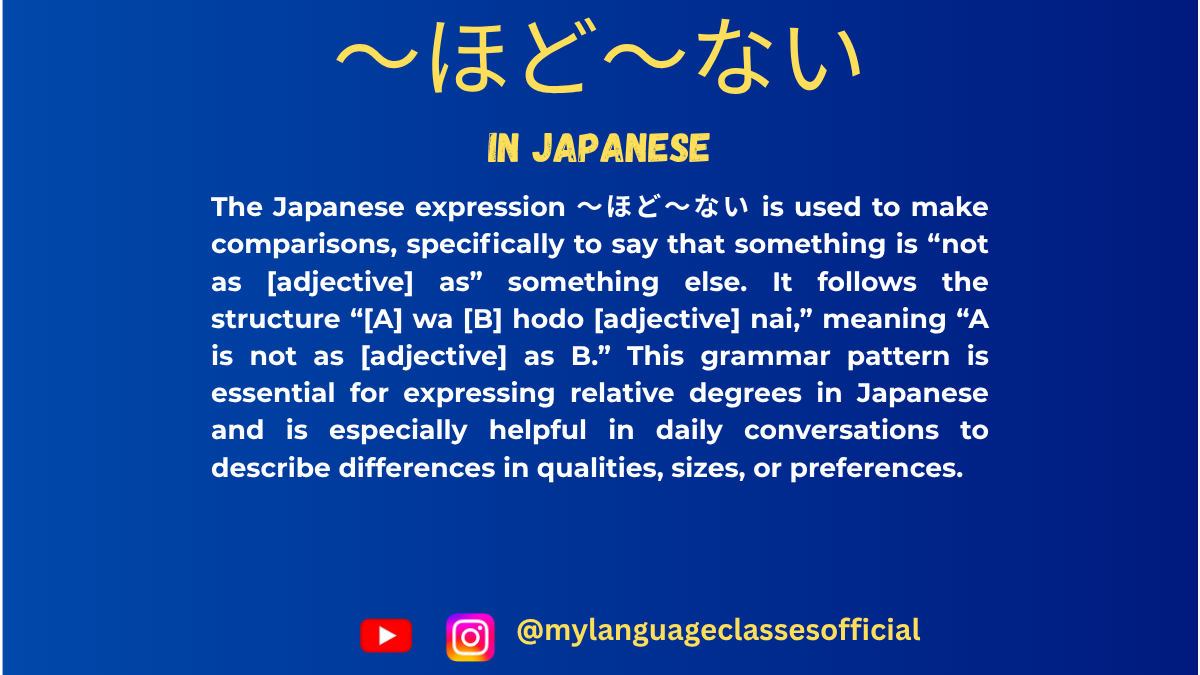
Using 〜ほど〜ない in Japanese | My Language Classes
Understanding 〜ほど〜ない in Japanese
The Japanese grammar pattern 「〜ほど〜ない」 is commonly used for making comparisons and expressing degree or extent. It implies that something is “not as much as” something else. This phrase is often translated as “not as… as…” in English.
Basic Structure of 〜ほど〜ない
The structure of this grammar pattern is as follows:
Noun + ほど + Adjective (ない-form)
or
Verb (dictionary form) + ほど + Adjective (ない-form)
General Meaning
「A ほど B ない」 means that B is not as A.
- A is the standard of comparison.
- B is the thing being compared.
Examples:
- この町は東京ほど賑やかではない。
(Kono machi wa Tōkyō hodo nigiyaka de wa nai.)
→ This town is not as lively as Tokyo. - 彼は私ほど速く走れない。
(Kare wa watashi hodo hayaku hashirenai.)
→ He cannot run as fast as I do. - この問題は思ったほど難しくない。
(Kono mondai wa omotta hodo muzukashiku nai.)
→ This problem is not as difficult as I thought.
Situations Where 〜ほど〜ない is Used
1. Comparing Extent or Degree
- Used when two things are compared, but the second one (B) has less intensity than the first (A).
Example:
北海道の冬は東京の冬ほど寒くない。
(Hokkaidō no fuyu wa Tōkyō no fuyu hodo samuku nai.)
→ Hokkaido’s winter is not as cold as Tokyo’s winter.2. Expressing Subjective Opinions
- Often used to express personal opinions about differences in perception.
Example:
数学は国語ほど難しくないと思います。
(Sūgaku wa kokugo hodo muzukashiku nai to omoimasu.)
→ I think math is not as difficult as Japanese.3. Negative Comparison in Abilities or Characteristics
- Used when comparing someone’s ability or characteristics with another’s.
Example:
彼の英語は先生ほど上手ではない。
(Kare no eigo wa sensei hodo jōzu de wa nai.)
→ His English is not as good as the teacher’s.4. Comparing Expectations vs Reality
- Used when expectations were high, but the actual situation is not as expected.
Example:
この映画は評判ほど面白くない。
(Kono eiga wa hyōban hodo omoshiroku nai.)
→ This movie is not as interesting as its reputation suggests.5. Comparing Feelings and Emotions
- Used when talking about feelings that are not as strong as expected.
Example:
彼は私が思ったほど優しくない。
(Kare wa watashi ga omotta hodo yasashiku nai.)
→ He is not as kind as I thought.6. Comparing Physical Condition or Health
- Used to compare health conditions or physical states.
Example:
風邪は思ったほどひどくない。
(Kaze wa omotta hodo hidoku nai.)
→ The cold is not as bad as I thought.7. Comparing Amount or Frequency
- Used when comparing quantity or frequency of actions.
Example:
今日は昨日ほど忙しくない。
(Kyō wa kinō hodo isogashiku nai.)
→ Today is not as busy as yesterday.8. Comparing Importance or Necessity
- Used when comparing levels of importance or necessity.
Example:
宿題はテストほど大事ではない。
(Shukudai wa tesuto hodo daiji de wa nai.)
→ Homework is not as important as tests.9. Comparing Strength of Desire or Preference
- Used to compare desires, preferences, or interests.
Example:
私は映画を見るのが好きですが、本を読むほど好きではない。
(Watashi wa eiga o miru no ga suki desu ga, hon o yomu hodo suki de wa nai.)
→ I like watching movies, but not as much as reading books.
Key Points to Remember About 〜ほど〜ない
- It is used for making comparisons where the second element has less intensity.
- It is often used to express subjective opinions.
- It is used to compare expectations vs reality.
- It can be used in various contexts: ability, frequency, amount, physical conditions, and emotions.
- It follows a simple pattern: “A ほど B ない”, where A is the standard, and B is the thing being compared.
Conclusion
The 「〜ほど〜ない」 grammar pattern is an essential part of Japanese when making negative comparisons. Mastering it will help you express your opinions, compare things effectively, and sound more natural in conversations. Make sure to practice using this structure in daily life to reinforce your understanding!
If you enjoyed this lesson, be sure to check out more posts like this on my blog at My Language Classes. Don’t forget to subscribe my YouTube channel and follow me on Instagram for the latest language learning tips and lessons. Leave a comment below to share your thoughts, or ask any questions you have about nouns.
Happy learning! 😊
-
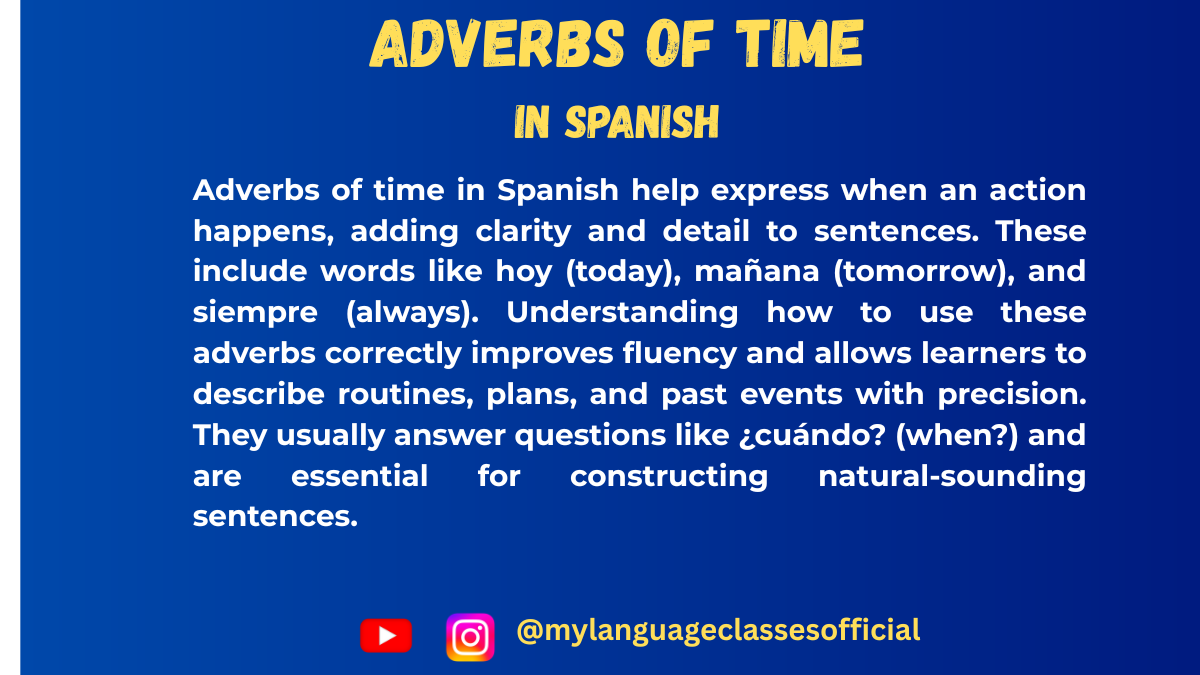
Adverbs of Time in Spanish: A Complete Guide
Adverbs of time (“los adverbios de tiempo”) are essential in Spanish to indicate when an action takes place. They help provide clarity and context to sentences, making conversations more precise. In this article, we will explore common Spanish adverbs of time, their meanings, examples, and grammatical considerations.
What Are Adverbs of Time?
Adverbs of time modify verbs, adjectives, or other adverbs by indicating the timing of an action. They answer questions like ¿Cuándo? (When?) and ¿Cada cuánto tiempo? (How often?).
Common Spanish Adverbs of Time
Here is a list of frequently used adverbs of time in Spanish along with their meanings and example sentences:
1. Adverbs for Specific Points in Time
- Hoy (Today)
- Hoy es un día especial. (Today is a special day.)
- Mañana (Tomorrow)
- Mañana voy al médico. (Tomorrow I am going to the doctor.)
- Ayer (Yesterday)
- Ayer llovió mucho. (Yesterday it rained a lot.)
- Ahora (Now)
- Ahora estoy ocupado. (Now I am busy.)
- Luego (Later)
- Voy al cine, luego te llamo. (I am going to the cinema, later I will call you.)
- Antes (Before)
- Antes de salir, apaga la luz. (Before leaving, turn off the light.)
- Después (After)
- Después de cenar, salimos a caminar. (After dinner, we go for a walk.)
2. Adverbs for Frequency
- Siempre (Always)
- Siempre me levanto temprano. (I always wake up early.)
- Nunca / Jamás (Never)
- Nunca fumo. (I never smoke.)
- Jamás lo volveré a hacer. (I will never do it again.)
- A menudo (Often)
- Voy al gimnasio a menudo. (I go to the gym often.)
- De vez en cuando (From time to time)
- De vez en cuando voy al teatro. (From time to time, I go to the theater.)
- Raramente (Rarely)
- Raramente veo televisión. (I rarely watch TV.)
- Casi nunca (Almost never)
- Casi nunca como comida rápida. (I almost never eat fast food.)
3. Adverbs for Duration
- Todavía / Aún (Still, yet)
- Todavía no he terminado. (I have not finished yet.)
- Ya (Already)
- Ya terminé la tarea. (I already finished the homework.)
- Por fin / Finalmente (Finally)
- Finalmente llegó el paquete. (The package finally arrived.)
- Desde entonces (Since then)
- Desde entonces no hemos hablado. (Since then, we have not spoken.)
- Mientras (While)
- Escucho música mientras estudio. (I listen to music while I study.)
Grammar and Usage Considerations
1. Placement in a Sentence
- In most cases, adverbs of time appear at the beginning or the end of a sentence:
- Hoy tengo clases. (Today I have classes.)
- Tengo clases hoy. (I have classes today.)
- Some adverbs, like ya, are placed before the verb:
- Ya terminé mi trabajo. (I already finished my work.)
2. Agreement and Gender Considerations
- Unlike adjectives, adverbs do not change in gender or number.
- However, some time expressions require articles or prepositions, such as:
- El lunes pasado (Last Monday) vs. Los lunes (On Mondays)
- En la mañana (In the morning) vs. Por la mañana (During the morning)
Forming Adverbs of Time from Adjectives
1. Regular Formation (Adding -mente)
Many adverbs are formed by adding -mente to the feminine singular form of adjectives:
- Rápido (Fast) → Rápidamente (Quickly)
- Frecuente (Frequent) → Frecuentemente (Frequently)
2. Irregular Formation
Some adverbs do not follow the regular -mente rule and must be memorized:
- Bien (Well), Mal (Badly), Tarde (Late), Temprano (Early)
- Example: Él llegó tarde a la reunión. (He arrived late to the meeting.)
3. Using Prepositional Phrases as Adverbs of Time
Some expressions function as adverbs when combined with prepositions:
- De vez en cuando (From time to time)
- Cada día (Every day)
- Hace un rato (A while ago)
Common Mistakes to Avoid
- Confusing “ya” and “todavía”:
- Ya means “already”: Ya hice mi tarea. (I already did my homework.)
- Todavía means “still”: Todavía estoy haciendo mi tarea. (I am still doing my homework.)
- Misplacing “nunca” in negative sentences:
- Correct: Nunca he estado en España. (I have never been to Spain.)
- Incorrect: No he estado nunca en España. (Although this is sometimes used in spoken Spanish, it’s not grammatically preferred.)
Conclusion
Adverbs of time are fundamental for constructing clear and accurate sentences in Spanish. Understanding their placement, variations, and common expressions will enhance your fluency. By practicing these adverbs in different contexts, you will develop a more natural and precise way of speaking Spanish.
If you enjoyed this lesson, be sure to check out more posts like this on my blog at My Language Classes. Don’t forget to subscribe my YouTube channel and follow me on Instagram for the latest language learning tips and lessons. Leave a comment below to share your thoughts, or ask any questions you have.
Happy learning! 😊
- Hoy (Today)
-
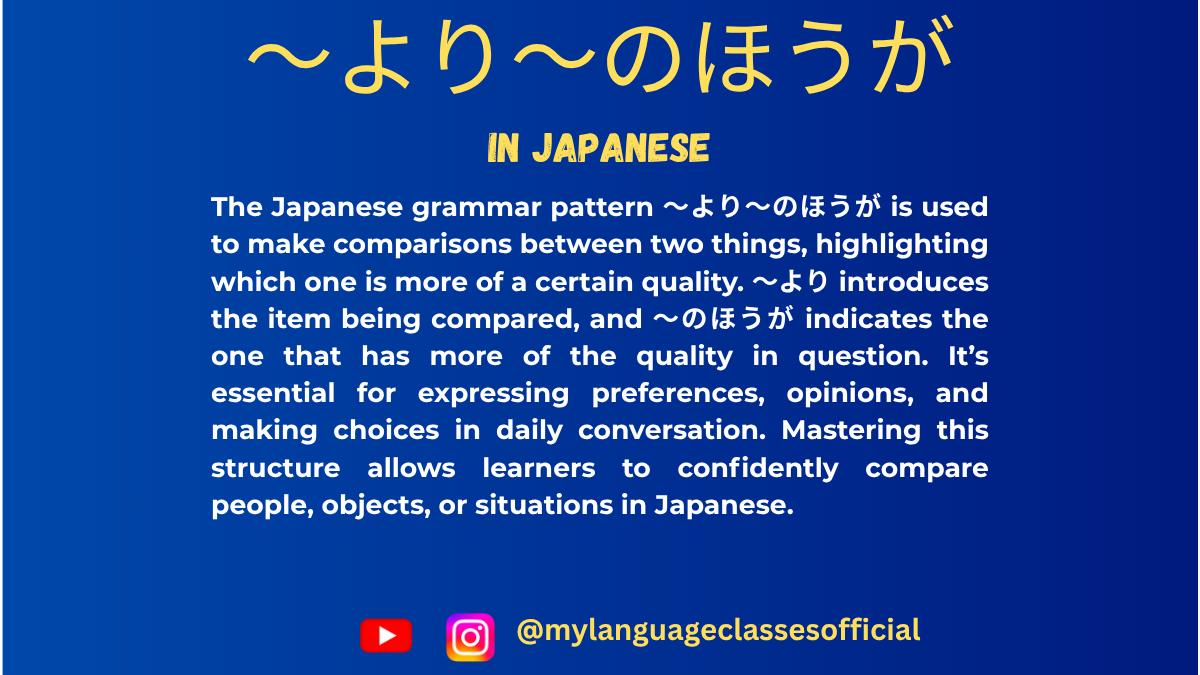
Understanding 〜より〜のほうが in Japanese | My Language Classes
Understanding 〜より〜のほうが
The construction 〜より〜のほうが is an essential tool in Japanese for making comparisons. It translates to “X is more than Y” or “X is better/more suitable than Y” and is widely used in everyday conversations, formal contexts, and written communication. This blog post dives into its meaning, usage, and various scenarios.
Structure of 〜より〜のほうが
The pattern is straightforward:
- Yより Xのほうが adjective/descriptive phrase.
- Yより: Indicates the thing being compared (Y).
- Xのほうが: Highlights the preferred or superior item (X).
Example:
- 犬より猫のほうが好きです。
(I like cats more than dogs.)
Core Uses of 〜より〜のほうが
- Preference
When expressing a preference between two items, activities, or options:- 旅行より勉強のほうが楽しいです。
(Studying is more fun than traveling.)
- 旅行より勉強のほうが楽しいです。
- Quantitative Comparisons
Highlighting differences in measurable qualities like size, speed, or price:- バスより電車のほうが早いです。
(Trains are faster than buses.) - このレストランよりあのレストランのほうが安いです。
(That restaurant is cheaper than this one.)
- バスより電車のほうが早いです。
- Capabilities
Used to compare abilities or skills:- 英語より日本語のほうが得意です。
(I’m better at Japanese than English.)
- 英語より日本語のほうが得意です。
- Frequency or Intensity
Comparing how often or how strongly something occurs:- 冬より夏のほうが好きです。
(I like summer more than winter.)
- 冬より夏のほうが好きです。
- Hypotheticals
For discussing hypothetical preferences or outcomes:- 映画館より家で映画を見たほうがいいです。
(Watching a movie at home is better than going to the cinema.)
- 映画館より家で映画を見たほうがいいです。
- Suitability
Indicating one option is more suitable for a specific purpose:- この仕事には男性より女性のほうが適しています。
(For this job, women are more suitable than men.)
- この仕事には男性より女性のほうが適しています。
Situations Where 〜より〜のほうが is Used
- Daily Conversations
- Comparing food, hobbies, weather, or locations:
- 寿司よりラーメンのほうがおいしいと思います。
(I think ramen is tastier than sushi.)
- 寿司よりラーメンのほうがおいしいと思います。
- Comparing food, hobbies, weather, or locations:
- Business and Professional Settings
- Discussing product qualities or work efficiency:
- この方法よりその方法のほうが効率的です。
(That method is more efficient than this one.)
- この方法よりその方法のほうが効率的です。
- Discussing product qualities or work efficiency:
- Travel and Leisure
- Comparing destinations, travel modes, or activities:
- 海外旅行より国内旅行のほうが安心です。
(Domestic travel is safer than international travel.)
- 海外旅行より国内旅行のほうが安心です。
- Comparing destinations, travel modes, or activities:
- Education and Learning
- Comparing subjects or teaching methods:
- 自習より先生に教えてもらうほうがいいです。
(Being taught by a teacher is better than self-study.)
- 自習より先生に教えてもらうほうがいいです。
- Comparing subjects or teaching methods:
- Relationships and Social Scenarios
- Evaluating people or interpersonal qualities:
- 彼より彼女のほうが優しいです。
(She is kinder than him.)
- 彼より彼女のほうが優しいです。
- Evaluating people or interpersonal qualities:
Key Notes
- Implied Context:
In conversational Japanese, the context often allows for the omission of repetitive elements:- 映画よりドラマのほうが好きです。(I like dramas more than movies.)
Can be shortened to:- ドラマのほうが好きです。 (I like dramas more.)
- 映画よりドラマのほうが好きです。(I like dramas more than movies.)
- Neutrality:
The phrase is neutral and doesn’t carry judgmental connotations, making it versatile for all scenarios. - Politeness Levels:
Depending on the situation, you can adjust politeness levels:- Casual: 〜より〜のほうがいい。
- Polite: 〜より〜のほうがいいです。
- Formal: 〜より〜のほうが適切です。
Practice Examples
- 自転車より車のほうが速いです。
(Cars are faster than bicycles.) - テレビを見るより本を読むほうがいいです。
(Reading books is better than watching TV.) - 東京より大阪のほうが住みやすいと思います。
(I think Osaka is easier to live in than Tokyo.)
By mastering 〜より〜のほうが, you can convey nuanced preferences and comparisons effectively. Practice using it in different contexts to build fluency!
What comparisons will you try making today? Let me know in the comments!
If you enjoyed this lesson, be sure to check out more posts like this on my blog at My Language Classes. Don’t forget to subscribe my YouTube channel and follow me on Instagram for the latest language learning tips and lessons. Leave a comment below to share your thoughts, or ask any questions you have about nouns.
Happy learning! 😊
- Yより Xのほうが adjective/descriptive phrase.
-
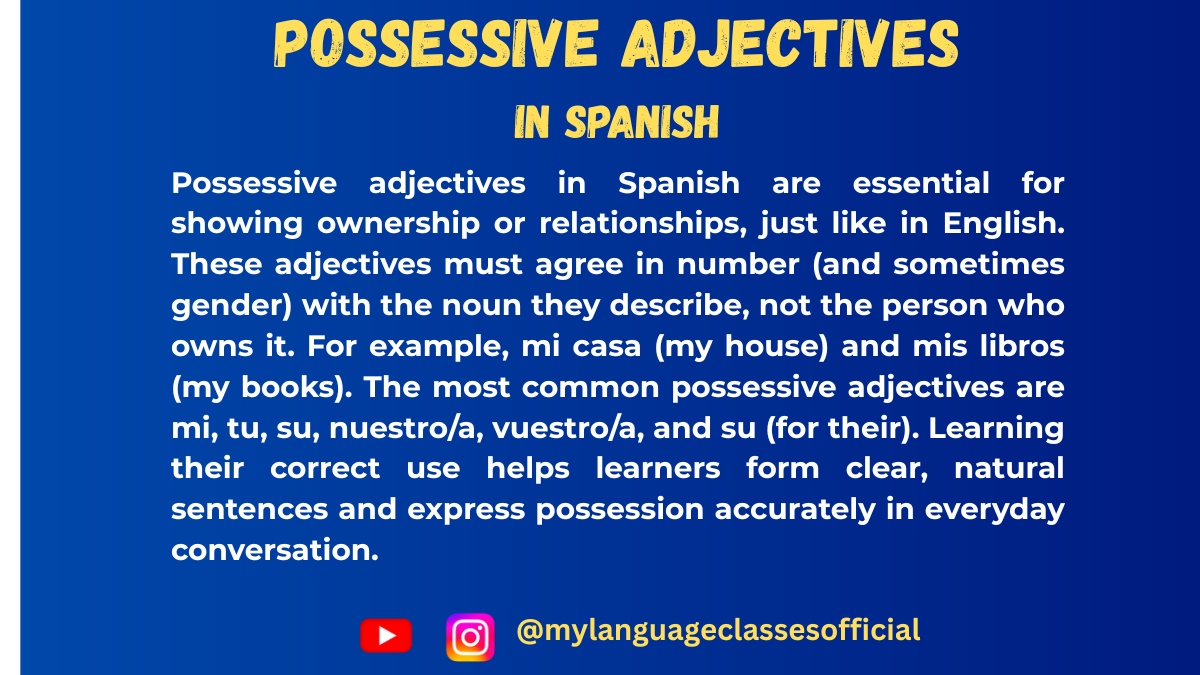
Possessive Adjectives in Spanish
Possessive adjectives in Spanish are essential for indicating ownership or relationships. They agree in gender and number with the noun they modify and are categorized into two forms: short-form possessive adjectives and long-form possessive adjectives.
Short-Form Possessive Adjectives
These adjectives come before the noun and agree only in number (except for “nuestro” and “vuestro,” which also agree in gender).
Singular Possessor Singular Noun Plural Noun mi (my) mi casa (my house) mis casas (my houses) tu (your, informal) tu coche (your car) tus coches (your cars) su (his, her, its, your formal) su perro (his dog) sus perros (his dogs) nuestro/a (our) nuestro amigo (our friend) nuestros amigos (our friends) vuestro/a (your, plural informal) vuestra madre (your mother) vuestras madres (your mothers) su (their, your plural formal) su profesor (their teacher) sus profesores (their teachers) Examples Sentences:
- Mi casa es grande. (My house is big.)
- Tus zapatos son nuevos. (Your shoes are new.)
- Su hermano vive en Madrid. (His brother lives in Madrid.)
- Nuestra escuela es moderna. (Our school is modern.)
- Vuestras mochilas están en la mesa. (Your backpacks are on the table.)
- Sus ideas son interesantes. (Their ideas are interesting.)
Long-Form Possessive Adjectives
These adjectives come after the noun and agree in both gender and number with the noun. They emphasize ownership.
Singular Possessor Singular Masculine Singular Feminine Plural Masculine Plural Feminine mío/a (mine) el libro mío (my book) la casa mía (my house) los libros míos (my books) las casas mías (my houses) tuyo/a (yours, informal) el coche tuyo (your car) la bolsa tuya (your bag) los coches tuyos (your cars) las bolsas tuyas (your bags) suyo/a (his, hers, yours formal) el perro suyo (his dog) la idea suya (her idea) los perros suyos (his dogs) las ideas suyas (her ideas) nuestro/a (ours) el amigo nuestro (our friend) la profesora nuestra (our teacher) los amigos nuestros (our friends) las profesoras nuestras (our teachers) vuestro/a (yours, plural informal) el coche vuestro (your car) la casa vuestra (your house) los coches vuestros (your cars) las casas vuestras (your houses) suyo/a (theirs, yours plural formal) el libro suyo (their book) la comida suya (their food) los libros suyos (their books) las comidas suyas (their foods) Examples Sentences:
- Esa mochila es mía. (That backpack is mine.)
- El coche rojo es tuyo. (The red car is yours.)
- La casa grande es suya. (The big house is his/hers.)
- La responsabilidad es nuestra. (The responsibility is ours.)
- El problema es vuestro. (The problem is yours.)
- Las ideas son suyas. (The ideas are theirs.)
Key Differences Between Short and Long Forms
- Position in the sentence: Short forms come before the noun; long forms come after the noun.
- Emphasis: Long forms emphasize possession and ownership more strongly.
- Agreement: Long forms agree in both gender and number, whereas short forms only change for number (except “nuestro” and “vuestro”).
Common Expressions Using Possessive Adjectives
Here are some useful phrases commonly used in daily life:
Spanish English Mi amor My love Mi casa es tu casa My house is your house (Feel at home) A su servicio At your service En su tiempo libre In his/her free time A mi manera In my way A su gusto To his/her liking Nuestros pensamientos Our thoughts Vuestra responsabilidad Your responsibility Lo mío es importante What is mine is important Un amigo mío A friend of mine Example Sentences Using Expressions:
- Mi casa es tu casa, siéntete cómodo. (My house is your house, make yourself comfortable.)
- A su gusto, puede elegir cualquier opción. (To his/her liking, they can choose any option.)
- En su tiempo libre, le gusta leer. (In his/her free time, he/she likes to read.)
- Nuestros pensamientos son similares. (Our thoughts are similar.)
Things to Keep in Mind When Using Possessive Adjectives
- Article Usage: Short-form possessive adjectives do not need an article, while long-form adjectives can be used with definite articles (el, la, los, las):
- Mi coche es rojo. (My car is red.)
- El coche mío es rojo. (The car of mine is red.)
- Plural and Gender Agreement:
- If the noun is plural, the possessive adjective must be plural.
- If the noun is feminine, adjectives ending in -o change to -a (e.g., “mío” → “mía”).
- Ambiguity of “su/sus”: “Su” and “sus” can mean “his, her, their, your (formal),” leading to confusion. To clarify, use “de + pronoun/name”:
- Su coche es nuevo. (His/her/your/their car is new.)
- El coche de Juan es nuevo. (Juan’s car is new.)
- El coche de ellos es nuevo. (Their car is new.)
Final Thoughts
Possessive adjectives are an integral part of Spanish grammar, making conversations clearer and more precise. Understanding the difference between short and long forms, as well as their proper agreement with nouns, will greatly improve your fluency. Practice using these adjectives in daily conversations, and soon, they’ll become second nature!
Did you find this guide helpful?
Let us know in the comments below or practice by writing a few sentences using possessive adjectives!
If you enjoyed this lesson, be sure to check out more posts like this on my blog at My Language Classes. Don’t forget to subscribe my YouTube channel and follow me on Instagram for the latest language learning tips and lessons. Leave a comment below to share your thoughts, or ask any questions you have.
Happy learning! 😊
-

Understanding “〜てはいけない” in Japanese | My Language Classes
How to Use 〜てはいけない
The phrase “〜てはいけない” is a common Japanese grammatical structure used to express prohibition, or things that are not allowed. It translates to “must not” or “cannot” in English. This phrase is widely used in various contexts, from giving instructions to setting rules.
Formation of 〜てはいけない
The structure “〜てはいけない” is formed by attaching て-form of a verb to はいけない. Here’s how it works:
- Convert the verb to its て-form.
- Add はいけない to the end of the verb.
Example:
- 食べる (to eat) → 食べてはいけない (must not eat)
- 行く (to go) → 行ってはいけない (must not go)
Situations Where “〜てはいけない” is Used
- Rules and Regulations
Used to express prohibitions in formal and informal rules:- 学校で携帯電話を使ってはいけない。
(You must not use mobile phones at school.) - ここでタバコを吸ってはいけません。
(You must not smoke here.)
- 学校で携帯電話を使ってはいけない。
- Giving Orders or Instructions
Often used in scenarios where instructions need to be clear:- 試験中に話してはいけない。
(You must not talk during the exam.) - このドアを開けてはいけません。
(You must not open this door.)
- 試験中に話してはいけない。
- Moral or Ethical Prohibitions
Refers to socially unacceptable behaviors:- 他人のものを勝手に使ってはいけない。
(You must not use someone else’s belongings without permission.) - 嘘をついてはいけません。
(You must not lie.)
- 他人のものを勝手に使ってはいけない。
- Safety Warnings
Used to highlight actions that could lead to danger:- この薬を飲んでお酒を飲んではいけません。
(You must not drink alcohol after taking this medicine.) - 火のそばで遊んではいけない。
(You must not play near fire.)
- この薬を飲んでお酒を飲んではいけません。
- Expressing Social Norms
Indicates socially expected behaviors or taboos:- ご飯を食べながらしゃべってはいけません。
(You must not talk while eating.)
- ご飯を食べながらしゃべってはいけません。
- Parent-Child or Teacher-Student Scenarios
Frequently used in educational or authoritative contexts:- 遅くまでテレビを見てはいけない。
(You must not watch TV until late.) - 宿題を忘れてはいけません。
(You must not forget your homework.)
- 遅くまでテレビを見てはいけない。
Points to Remember
- Polite Variations
In formal or polite speech, いけない can be replaced with いけません:- ここに入ってはいけません。
(You must not enter here.)
- ここに入ってはいけません。
- Casual Variations
In casual speech, てはいけない may become ちゃいけない or じゃいけない:- そんなことしちゃいけないよ!
(You shouldn’t do that!)
- そんなことしちゃいけないよ!
- Cultural Context
Understanding when to use “〜てはいけない” depends on the context. Japanese culture often emphasizes politeness and indirectness. Therefore, use polite forms in formal settings to avoid sounding harsh.
Examples of Verbs and Usage
Verb (Dictionary Form) て-Form Usage Example 飲む (to drink) 飲んで お酒を飲んではいけない。(You must not drink alcohol.) 遊ぶ (to play) 遊んで 道路で遊んではいけない。(You must not play on the road.) 書く (to write) 書いて 壁に書いてはいけません。(You must not write on the wall.) 行く (to go) 行って 危険な場所に行ってはいけない。(You must not go to dangerous places.) 話す (to talk) 話して 授業中に話してはいけません。(You must not talk during class.)
List of Situations for “〜てはいけない”
- At school (e.g., no phones, no talking during tests)
- At work (e.g., no eating at desks, no accessing unauthorized files)
- Public spaces (e.g., no littering, no smoking in non-smoking zones)
- During social interactions (e.g., no interrupting others, no offensive comments)
- While driving (e.g., no using phones, no speeding)
- At home (e.g., no playing with dangerous tools, no staying up too late)
- With safety rules (e.g., no entering restricted areas, no consuming certain substances)
By understanding and mastering the use of “〜てはいけない,” you can effectively communicate prohibitions and rules in Japanese. This structure is crucial for clear, polite, and culturally appropriate expressions in both written and spoken Japanese.
If you enjoyed this lesson, be sure to check out more posts like this on my blog at My Language Classes. Don’t forget to subscribe my YouTube channel and follow me on Instagram for the latest language learning tips and lessons. Leave a comment below to share your thoughts, or ask any questions you have about nouns.
Happy learning! 😊
-
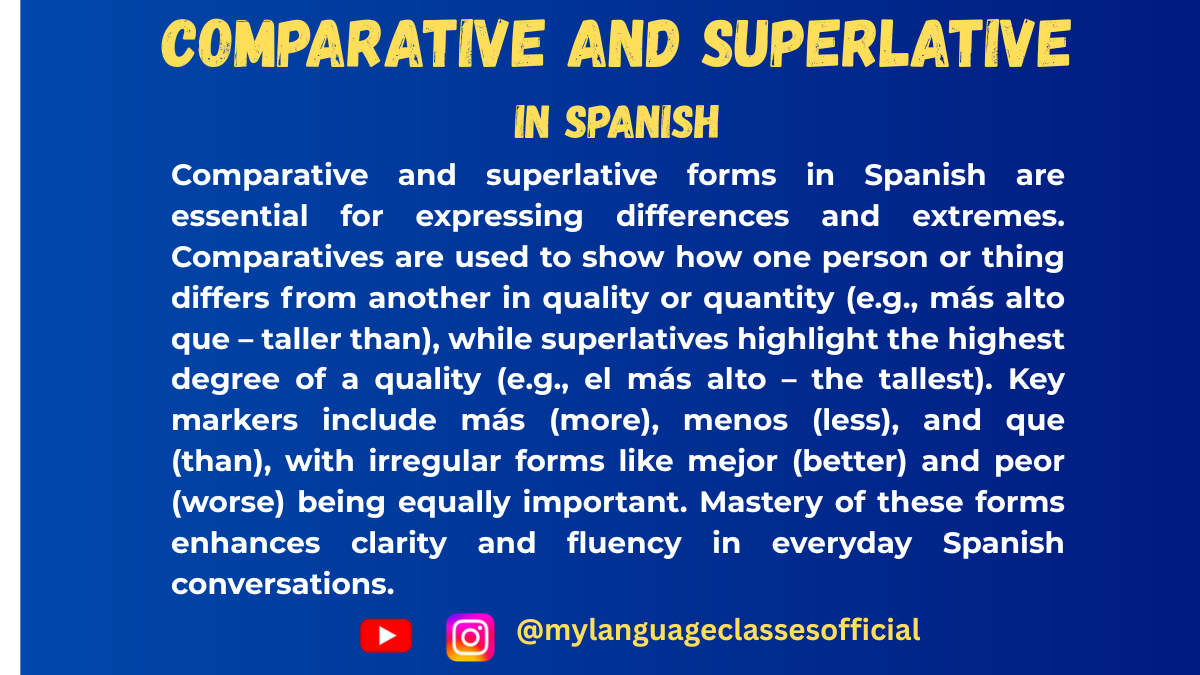
Comparative and Superlative Forms of Adjectives in Spanish
Adjectives in Spanish are essential for describing people, places, and things. Understanding how to form and use comparative and superlative adjectives is crucial for effective communication, especially when comparing or emphasizing characteristics.
Comparative Forms of Adjectives
Comparative adjectives are used to compare two entities. In Spanish, there are three types:
- Comparative of Superiority (more than): más + adjective + que
- Comparative of Equality (as…as): tan + adjective + como
- Comparative of Inferiority (less than): menos + adjective + que
Superlative Forms of Adjectives
Superlatives express the highest or lowest degree of a quality. There are two types:
- Relative Superlative: Used to indicate “the most” or “the least” within a group.
- Formula: el/la/los/las + más/menos + adjective + de
- Absolute Superlative: Used to indicate “very” or “extremely” without comparison.
- Formula: Add -ísimo/a/os/as to the adjective. For example, alto → altísimo.
Key Points to Remember
- Gender and Plurality:
Adjectives must agree in gender (masculine/feminine) and number (singular/plural) with the noun they modify.- Examples:
- El coche más rápido. (The fastest car.)
- Las casas más grandes. (The biggest houses.)
- Examples:
- Articles in Superlatives:
Use the definite article (el, la, los, las) before the superlative form to specify the subject.- Example: Es la persona más amable. (She is the kindest person.)
- Irregular Adjectives:
Some adjectives have irregular comparative and superlative forms that don’t follow standard rules.
Forming Comparatives and Superlatives
Regular Adjectives
- Más + adjective + que
- Example: Pedro es más alto que Juan. (Pedro is taller than Juan.)
- Tan + adjective + como
- Example: María es tan inteligente como Ana. (María is as intelligent as Ana.)
- Menos + adjective + que
- Example: Este libro es menos interesante que ese. (This book is less interesting than that one.)
Irregular Adjectives
Some adjectives have unique forms:
- Bueno (good) → mejor (better) → el mejor (the best)
- Malo (bad) → peor (worse) → el peor (the worst)
- Grande (big) → mayor (bigger/older) → el mayor (the biggest/oldest)
- Pequeño (small) → menor (smaller/younger) → el menor (the smallest/youngest)
List of Common Adjectives with Comparative and Superlative Forms
Adjective Comparative Superlative Example Sentence Alto (tall) más alto el más alto Juan es más alto que Pedro. (Juan is taller than Pedro.) Bajo (short) menos bajo el menos bajo Luis es el menos bajo del grupo. (Luis is the shortest in the group.) Bueno (good) mejor el mejor Este libro es mejor que el otro. (This book is better than the other.) Malo (bad) peor el peor Ese día fue el peor de mi vida. (That day was the worst of my life.) Grande (big) mayor el mayor Ella es la mayor de sus hermanas. (She is the oldest of her sisters.) Pequeño (small) menor el menor Este cuarto es el menor de todos. (This room is the smallest of all.)
Daily Expressions Using Comparatives and Superlatives
Spanish Expression Translation Example Sentence Más vale tarde que nunca. Better late than never. Llegaste tarde, pero más vale tarde que nunca. El más mínimo detalle. The slightest detail. No olvides el más mínimo detalle. Es peor el remedio que la enfermedad. The cure is worse than the disease. No aceptes esa solución, es peor el remedio que la enfermedad.
Common Situations for Usage
- Describing People:
- Ella es más simpática que su hermana. (She is nicer than her sister.)
- Talking About Places:
- Este restaurante es el más famoso de la ciudad. (This restaurant is the most famous in the city.)
- Comparing Objects:
- Este coche es mejor que aquel. (This car is better than that one.)
Tips for Mastery
- Memorize Irregular Forms: Focus on learning irregular adjectives as they’re used frequently.
- Practice Gender Agreement: Always match adjectives to the gender and number of the noun.
- Use Common Expressions: Integrating idiomatic expressions into your speech will make you sound more natural.
With consistent practice and attention to detail, mastering comparative and superlative adjectives in Spanish becomes an achievable goal!
If you enjoyed this lesson, be sure to check out more posts like this on my blog at My Language Classes. Don’t forget to subscribe my YouTube channel and follow me on Instagram for the latest language learning tips and lessons. Leave a comment below to share your thoughts, or ask any questions you have.
Happy learning! 😊

